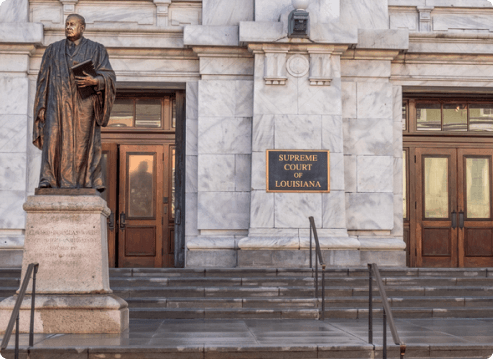
New Orleans, LA 70170
- $500 Million Recovered
- Serves Clients Nationwide
- Rated a “Hall of Fame” law firm by The Legal 500
Asbestos exposure in Louisiana shipyards, oil refineries and other job sites caused mesothelioma in the state’s residents. Veterans were also exposed at military bases. Louisiana mesothelioma lawyers from top asbestos law firms help mesothelioma patients and their families access compensation.

The first step in filing a mesothelioma claim in Louisiana is finding an asbestos law firm to handle your claim. Make sure to find a firm that is familiar with the state’s asbestos litigation laws.
Your mesothelioma lawyer should understand how the state’s laws may affect your case. For example, when it comes to the state’s comparative fault system, a skilled lawyer can build a strong case to minimize any claims of shared responsibility.
Key Facts About Filing Louisiana Asbestos Claims
While Louisiana’s statute of limitations means you may have less time to file a claim in the state, don’t be discouraged if you’ve already passed that time frame. An experienced mesothelioma attorney may be able to find exceptions that exist in your case.
You may also be able to file your mesothelioma claim in another state. This may be the case if your exposure happened elsewhere or the defendant is headquartered somewhere else.
Louisiana mesothelioma lawyers have experience navigating the state’s courts. They’re also experienced in identifying liable parties, such as employers and manufacturers who exposed workers to asbestos.
Workers have been exposed to asbestos in small and large cities across Louisiana, including New Orleans, Baton Rouge, Lafayette and Slidell. Those who develop mesothelioma and other asbestos diseases may be eligible to seek compensation through lawsuits and asbestos trust fund claims.
Hiring a qualified mesothelioma attorney increases your chances of receiving the maximum compensation in Louisiana. The best firms will alleviate your stress so you can focus on your health and family.
Top mesothelioma lawyers in New Orleans include the team at Nemeroff Law. The firm has a reputation for securing some of the highest verdicts and settlements in Louisiana. Nemeroff’s recent mesothelioma settlements have included a $17.4 million settlement for a young man who had secondary exposure through his father.
They also negotiated a $10 million mesothelioma settlement for an insulator in Louisiana. The firm is known for its skill in unearthing evidence of asbestos exposure at Louisiana jobsites. Nemeroff has held many Louisiana companies responsible for the diseases their asbestos products have caused in residents.

Lawyers at national mesothelioma law firms are licensed to practice throughout the United States. Nationwide asbestos lawyers have robust resources and experience. They handle all types of cases and know how to find the right jurisdiction for your claim. In 2022, Weitz & Luxenburg secured $43 million for a mesothelioma patient after a jury found Algoma Hardwoods responsible for asbestos exposure.
If you can’t travel, a perk of selecting a national asbestos law firm is they’ll typically travel to you. They regularly travel long distances to meet with clients and record depositions. Generally, they don’t charge clients for these travel expenses.





Louisiana courts have a recent history of awarding mesothelioma compensation to plaintiffs. These courts also have a history of siding with asbestos defendants. This underscores the importance of working with a Louisiana law firm with a record of success in the state.
In Louisiana courts, Nemeroff attorneys have argued many cases that received multimillion-dollar verdicts. They secured a $12 million verdict for an industrial worker in 2016. They won another $12 million verdict in 2012 for a shipyard worker.
Notable Louisiana Settlements and Verdicts
Nemeroff Law secured a $9.25 million verdict for two families of oil refinery workers in 2011. They also secured a $7.5 million verdict from a New Orleans jury in 2011 for a pipefitter exposed to asbestos in the 1970s and 1980s.
Nationwide firms have also had success in Louisiana courts. In 2022, Weitz & Luxenberg secured $43 million for a mesothelioma patient after a jury found Algoma Hardwoods responsible for asbestos exposure.

Get help finding an attorney who knows the process and can get you and your family the compensation you deserve.
Get Help NowLouisiana employs federal and state laws to regulate asbestos and prevent exposure among residents. It also takes federal regulations around asbestos in schools a step further with its own regulations, including provisions for training and accreditation.
The Louisiana Department of Environmental Quality oversees asbestos regulations in the state, including regulations that apply to school and state buildings. It also oversees training and accreditation of abatement workers. Louisiana is unique in that it requires an additional two-hour asbestos regulations course to become an accredited asbestos abatement worker in the state.
Louisiana Asbestos Laws, Codes and Statutes
Louisiana’s workers’ compensation laws may impact your case depending on when you were exposed to asbestos. Ensure you find a Louisiana-licensed mesothelioma attorney with experience applying these laws to asbestos claims.
With no naturally occurring asbestos within the state, occupational exposure is typically the main source of asbestos exposure in Louisiana. The industries in Louisiana most known for asbestos exposure include oil refining and shipbuilding. Workers have also been exposed in power plants, chemical plants and schools.
Sites Known for Asbestos Exposure in Louisiana
The city of New Orleans was forever changed when Hurricane Katrina hit on Aug. 29, 2005. Hurricane floods damaged many older homes containing legacy asbestos.
Until Aug. 29, 2008, the EPA allowed debris that could have contained asbestos to enter landfills not approved for such waste. This action helped to clean up debris in a timelier manner but may have exposed people to asbestos in the process. The state issued seven air quality violations by the end of 2008 relating to the handling of asbestos materials in landfills.
Louisiana residents face exposure risks in certain occupational settings known for asbestos use. Examples in Louisiana include power plants, oil refineries, shipyards and industrial plants. The state has no natural asbestos deposits. Some companies dumped asbestos waste throughout Louisiana that contaminated the soil and groundwater.
Veterans of the U.S. armed forces have been exposed to asbestos at Louisiana shipyards and military bases. For example, veterans may have been exposed at NSA New Orleans Navy Base, Marine Corps Support Facility in New Orleans and Camp Beauregard Army Base in Pineville, Louisiana.
Higher-Risk Occupations
An occupation often forgotten to be at risk of asbestos exposure is first responders. Police, firefighters, and volunteers who responded to Hurricane Katrina were exposed to asbestos. Demolition crews who worked on homes and buildings damaged by Hurricane Katrina were exposed to asbestos through cleanup efforts.
Asbestos companies have been held liable in Louisiana for the diseases their products cause. For example, Louisiana courts have held Tenneco, Entergy and W.R. Grace responsible for cases of mesothelioma among the state’s residents.
Recommended ReadingYour web browser is no longer supported by Microsoft. Update your browser for more security, speed and compatibility.
If you are looking for mesothelioma support, please contact our Patient Advocates at (855) 404-4592
The Mesothelioma Center at Asbestos.com has provided patients and their loved ones the most updated and reliable information on mesothelioma and asbestos exposure since 2006.
Our team of Patient Advocates includes a medical doctor, a registered nurse, health services administrators, veterans, VA-accredited Claims Agents, an oncology patient navigator and hospice care expert. Their combined expertise means we help any mesothelioma patient or loved one through every step of their cancer journey.
More than 30 contributors, including mesothelioma doctors, survivors, health care professionals and other experts, have peer-reviewed our website and written unique research-driven articles to ensure you get the highest-quality medical and health information.
My family has only the highest compliment for the assistance and support that we received from The Mesothelioma Center. This is a staff of compassionate and knowledgeable individuals who respect what your family is experiencing and who go the extra mile to make an unfortunate diagnosis less stressful. Information and assistance were provided by The Mesothelioma Center at no cost to our family.LashawnMesothelioma patient’s daughter


Lahav, J. (2025, June 16). Louisiana Mesothelioma Lawyers. Asbestos.com. Retrieved July 7, 2025, from https://www.asbestos.com/mesothelioma-lawyer/louisiana/
Lahav, Joe. "Louisiana Mesothelioma Lawyers." Asbestos.com, 16 Jun 2025, https://www.asbestos.com/mesothelioma-lawyer/louisiana/.
Lahav, Joe. "Louisiana Mesothelioma Lawyers." Asbestos.com. Last modified June 16, 2025. https://www.asbestos.com/mesothelioma-lawyer/louisiana/.
Co-Founding Partner at Weitz & Luxenberg
Co-Founding Partner at Weitz & Luxenberg
Managing Partner at Weitz & Luxenberg
Associate Attorney at Weitz & Luxenberg
Associate Attorney at Weitz & Luxenberg
Associate Attorney at Weitz & Luxenberg
Associate Attorney at Weitz & Luxenberg
Associate Attorney at Weitz & Luxenberg
Associate Attorney at Weitz & Luxenberg
Managing Partner at Simmons Hanly Conroy
Managing Partner at Simmons Hanly Conroy
Managing Partner at Simmons Hanly Conroy
Managing Partner at Simmons Hanly Conroy
Managing Partner at Simmons Hanly Conroy
Founding Partner at Meirowitz & Wasserberg, LLP
Founding Partner at Meirowitz & Wasserberg, LLP
Managing Partner at Meirowitz & Wasserberg, LLP
Senior Trial Lawyer at Meirowitz & Wasserberg, LLP
Associate Attorney at Meirowitz & Wasserberg, LLP
Associate Attorney at Meirowitz & Wasserberg, LLP
Associate Attorney at Meirowitz & Wasserberg, LLP
Associate Attorney at Meirowitz & Wasserberg, LLP
Associate Attorney at Meirowitz & Wasserberg, LLP
Associate Attorney at Meirowitz & Wasserberg, LLP
Associate Attorney at Meirowitz & Wasserberg, LLP
A mesothelioma lawyer who specializes in asbestos litigation reviewed the content on this page to ensure it is legally accurate.
William A. Davis is an attorney specializing in complex commercial litigation, with an emphasis in health care disputes, at a firm he founded in Washington, D.C. He also serves as senior counsel at The Peterson Firm.
Our fact-checking process begins with a thorough review of all sources to ensure they are high quality. Then we cross-check the facts with original medical or scientific reports published by those sources, or we validate the facts with reputable news organizations, medical and scientific experts and other health experts. Each page includes all sources for full transparency.
Please read our editorial guidelines to learn more about our content creation and review process.
